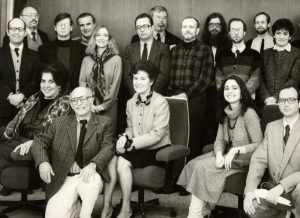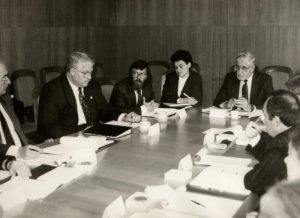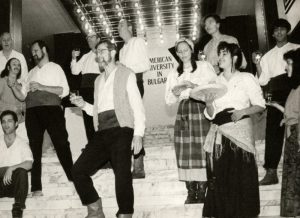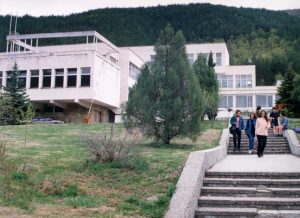Excerpted and adapted from “The American University…Where? ” (2011) by Dr. Robert Phillips Jr., Associate Professor of Politics at AUBG.
Looking at the founding of the American University in Bulgaria in thatvery first, very fragile 1991-1992 period, it is difficult to find a hero. This is a story, but it doesn’t have a hero. Instead, it is a story of hundreds if not thousands of people who simply heard, as Willman says, an idea that was “compelling and strong,” liked it, and wanted to do something to help it along.
“A few people can make big differences,” says Pantiza. Yes, people matter. And lots of people can make a really big difference. Add a little luck to that and there you have it—a university. But to get these people to matter in the first place is the difficult part. Yet, in the American University in Bulgaria these many people found something that moved them. Maybe they did not see the entire vision; maybe they saw only their own slight sliver of the vision. But it didn’t matter; because they saw it and they acted on it.
From the conclusion of “The American University…Where?”
I was in the army and my mother sent me an article from the newspaper.
She literally cut it out of the newspaper put it in the envelope and sent it to me. That was back in 1990.” Dimitar Natchkov, a native of Assenovgrad, was one of those first students. Like many of the male students in the first class, after graduation from Plovdiv English Language School in 1989 he was marched into the army for mandatory military service. “We didn’t have e-mail then; we used snail mail, so she used to write me letters twice a week…And I spoke about it with Manol [Manol Peikov, who would also become an AUBG student] because we were in the army together. And he said, ‘You know my mother also wrote a letter or either when she came to visit she told me that she saw a documentary on TV….’ And so we talked about it. …When we got discharged from the Army, which was in March of 1990, there was much more on TV and in the newspapers about this concept. So I said, ‘Well why don’t I try it?’”

As Natchkov notes, interest in the new university fed by press and word-of-mouth reports grew over the spring and early summer. By the time that Laverty arrived in Bulgaria in July 1991, the new university had become a hot press topic.
“We didn’t know what the requirements would be, so we called,” remembers Natchkov. “They told us that all applicants are welcome and that the two exams that would be taken for consideration are the SAT and TOEFL. They told us when the SAT and TOEFLs were going to take place in Blagoevgrad. So Manol and I started preparing ourselves because for a year and a half in the army we didn’t have the chance to practice our English that much, so we felt that we needed some preparation.”
Each year in the US, high school students planning to enter college
take the Scholastic Aptitude Test (SAT). It is a routine part of the college application process—in the US, that is. In 1991 Bulgaria, on the other hand, the SAT was unknown except to the few Bulgarians who were able to latch upon a copy of one of the preparation books sent by a friend studying in the US. But if the SAT was a challenge to students taking it, it was even a larger challenge to the team giving it.
“We didn’t know what the requirements would be, so we called,” remembers Natchkov.
Simply obtaining the tests had meant negotiating with a reluctant Educational Testing Service, the test’s creators, to agree to their being administered in Bulgaria. But allowing the tests, which are closely protected, to be brought over-involved more frustrating last-minute negotiations remembers Willman. After further talks, ETS eventually released a batch of institutional tests to Willman and Courtemanche, who ended up lugging them over on the plane as their excess baggage.



Milena Stoicheva, who had recently been hired to oversee student affairs, organized the testing process. Just recently a student herself at Sofia University, Stoicheva understood the difficult environment in which the university was being created. “There was a lack of belief that things would be done in a different way.”Honestly administered entrance tests and fair student selection procedures went largely unquestioned in the US, but in the aftermath of the previous system, suspicions of favoritism and connections were everywhere. For Stoicheva, this meant that “everything had to be transparent in an environment that had nothing like this before.” To help demonstrate that procedures would be carried out with integrity, she remembers locking the tests in the university safe and even sleeping with the key under her pillow.
“But if the SAT was a challenge to students taking it, it was even a larger challenge to the team giving it.”
This was not the end to the SAT saga. Without modern scanners to grade them, the tests had to be hand graded and application essays individually read. Limited human resources meant that the newly assembled Blagoevgrad team had to wear many hats during that summer; two of these hats became test grader and essay reader.

“Then we got results and it blew us away,” exclaims Laverty. “We didn’t think it was real at first. This was a second language. They had never taken a test like this before.” The test scores were indeed impressive and, at the time, meant that AUBG students rivaled the entering classes of some of the more prestigious universities in the US.
With no past, an under-construction present, and an uncertain future, it is hard to imagine the level of the uncertainty that surrounded AUBG in 1991. All who became part of it were taking a chance that the institution would be up and running by the end of September and that it would remain in operation after that. But for those first students, “they were risking, not us,” comments Zdravka Bojinova, who joined the university staff in August 1991. Danche Melnikliyska, also newly hired, agrees that the first class of students were taking a risk: “These people must have been very brave to believe us.”
When asked whether he was taking a risk by attending the new university, Natchkov matter-of-factly responds, “Actually, I looked at it as something exciting. I never questioned the possibility of this university not being able to succeed in the future.”
AUBG’s story began just a few short months earlier and its success was far from assured for a long time.
Eliana Maseva heard about the idea of an American-style university for Bulgaria sometime in the fall of 1990 at a meeting of deputies and members of the Union of Democratic Forces (UDF), the umbrella opposition group that had formed to challenge the recently renamed and reconfigured yet still dominant Bulgarian Socialist Party. At the time, she was the leader of the temporary executive committee of Blagoevgrad, a southwestern city of about 70,000, some 60 miles from Sofia.
“The idea was still very much up in the air for a university whose goal
would be an example and leader for change and reform in the educational system,” remembers Maseva. Just how this idea got up in the air in the first place is not exactly clear. No one involved in these early stages actually seems to remember who first came up with the idea of a university. If pressed, most will say it was John Menzies, the Press and Cultural Affairs Officer at the US Embassy in Sofia. Others think it could have been George Prohasky, Director of the Open Society Foundation-Sofia.
One of the earliest documented mentions of the idea dates from November 1990 within the Bulgarian Grand National Assembly. In a proposal for an American University of South-Eastern Europe to be situated in Sofia, Bodgan Atanassov, hoped that such an institution would allow the peoples of Southeast Europe to come together to learn. While several deputies supported this idea, at least one deputy groused that “such a university would be out of touch with the Bulgarian soul.”Atanassov, who would later teach English at the university, would see his idea partially realized in AUBG’s second year when Open Society Foundation scholarships brought the first Albanian and Romanian students to the university.
Maseva first met with John Menzies at the US embassy to discuss the idea formally and begin planning. Menzies, an energetic US career diplomat, was widely known and respected among democratic opposition circles of the time. “Menzies of course was a driving force in creating AUBG,” remarked Dimi Panitza, who would later become involved in the AUBG project on its Board of Directors. Many Bulgarians in the democratic opposition and any American visiting Bulgaria at the time would eventually meet the seemingly omnipresent Menzies.

“I felt that the location of Blagoevgrad was very good for such an institution that would help the stability of the Balkans in the long run,” Maseva said. “I also thought that this investment of the American University would be good for Southwest University and would introduce new educational examples to be followed. And last but not least, it would create liveliness in the town with two universities and a lot of young people. It would help the economy and commerce. We were saying to ourselves ‘Why don’t we make Blagoevgrad a little Oxford?’ Perhaps our dreams at the time were a little far-fetched, but I think that our thread of thinking was correct.”
As the group worked to finalize an offer from Blagoevgrad, the Open Society Foundation in Sofia, in consultation with Menzies, initiated a small feasibility study. Through this study, it was realized that the US connection for such an undertaking would either have to take place through a consortium of institutions or a single, larger institution. With this understanding, Menzies contacted officials at the University of Maine, which had been one of the first US institutions to host Bulgarian exchange students, to inquire about supporting the project.
Meanwhile, the Blagoevgrad group realized they would need wider support in the Bulgarian community. Zhelyu Zhelev, Bulgaria’s first democratically elected president, gave his blessing from the very start. “We all understood that Bulgarians needed a different type of politician, another kind of thinking, a much freer type of thinking…Out policy at the time was to open Bulgaria to the rest of the world. The fact that education [at the new University] would be in English was seen as particularly important given its importance in world politics and commerce,” Zhelev remembers.
“The idea was still very much up in the air for a university whose goal would be an example and leader for change and reform in the educational system.”
George Soros provided much needed financial backing early on. Another early supporter was Sol Polansky, who would later become the chair of the American AUBG board. Polansky was in the eyes of many uniquely suited for this position. As U.S. Ambassador to Bulgaria from 1987 to 1990, Polansky enjoyed a strong reputation as a good and sincere friend of Bulgaria. His stature within Bulgaria was such that his early commitment to the project assured many Bulgarians, including Maseva, that the still tentative project would be eventually realized.
Dimi Panitza, a Bulgarian émigré who made a name for himself in the world of journalism, jumped whole-heartedly into helping out with the project and would remain a passionate supporter of AUBG throughout his life.
University of Maine officials were also warming to the idea. During mid-fall 1990, UMaine President Dale Lick traveled to Bulgaria where he met Menzies and university supporters, including George Prohasky, Director of the Open Society Foundation, and an early advocate of an American university. With the idea of moving along in Bulgaria, a University of Maine team was sent at the end of March 1991 to evaluate the possibility of participating in the AUBG project.

The team was composed of Charles Rauch (Vice President for Finance and a retired navy admiral), Jim Sherburne (Director of the Office of International Affairs), John Hitt (Vice President for Academic Affairs), Marisue Pickering, and Ed Laverty (Executive Assistant to the President). Just some months later, Laverty would become AUBG’s first president. The team’s visit included meeting with the newly formed Bulgarian Initiative Committee, government and parliamentary officials, and US embassy officials, along with a trip to Blagoevgrad to see the possible facilities.
“We all understood that Bulgarians needed a different type of politician, another kind of thinking, a much freer type of thinking…”
Impressed with what they heard and saw in Bulgaria, the University of Maine team returned home as advocates of the idea and began convincing President Lick, who was interested in internationalizing the University of Maine campus. Bob Woodbury, Chancellor of the University of Maine System, shared this view—a fact that would bring a wise and valued ally to the AUBG cause at the University of Maine.

By 29 May, the Implementation Plan drafted by the University of Maine team was completed and would serve as a blueprint for the endeavor. As envisioned, the University of Maine would extend its accreditation to the fledgling university. AUBG would not become a branch campus of the Maine system; rather, it would develop under the supervision of Orono, the home of the University of Maine’s central campus. The University of Maine would be responsible for recruiting faculty and staff, devising a first-year curriculum, and providing administrative support among other responsibilities.
“There was this real sense of opportunity and possibility.”
With the plan settled and summer beginning, time came for assembling the American part of the team that would actually construct the university. Since the University of Maine held responsibility for this part of the plan, the administrative team was made up of individuals drawn from the University of Maine community.
Yet in 1991, Bulgaria, with its small émigré community, was simply way off the map for most Americans.
With only a few exceptions, the people who set up, became faculty, or became active supporters of AUBG had no family or diaspora connections with Bulgaria. “I had no, zero, personal connection with Bulgaria prior to this,” remarks Flanagan. Instead, other motivations brought them to the idea and, for some, to Bulgaria.
“There was this real sense of opportunity and possibility,” says Ed Laverty, AUBG’s first president. Laverty would relocate along with his wife, Roberta, and their children. Roberta Laverty would become both a problem solver and extra pair of hands for the team and eventually a faculty member. For Steve Kenney, a Maine native working in University of Maine’s financial offices at the time, AUBG offered a professional challenge, but that was not the sole motivation. Kenney, who became AUBG’s head financial officer, admits that “We fell in love with the whole concept.” Paula Dalzell-Kenney agrees: “The opportunity to start something from the ground up—just the whole idea of the wall coming down and the Soviet Union breaking up and Eastern Europe opening up, it was just really exciting to be on the cutting edge of what was happening there. For us…for two Maine kids to have that kind of opportunity was just really quite amazing.”
With the administrative team almost in place, Laverty remembers a conversation in which Chick Rauch told him, “You’re going to need a Radar O’Riley,” referring to a character on the popular television program, M*A*S*H. “You’re going to need someone who can do anything.” Several days later Laverty ran into Bill Porter, who oversaw ROTC on the Orono campus. Porter, a retired lieutenant colonel with command experience was invaluable at logistics and getting things to work. In addition to being remembered for his no-nonsense approach to problems Porter would be remembered for making the initial “American University in Bulgaria” sign that adorned the Main Building by personally cutting the letters out of Styrofoam and for introducing Bulgarian staff to their first doughnuts—years before the products would become commercially available. Pauline Porter, who “would help with everything” [1] during that first year, and their two kids would also join the team.
With the core group assembled and members arriving in late-June and July, the next step was simple—build a university in about 60 days.




